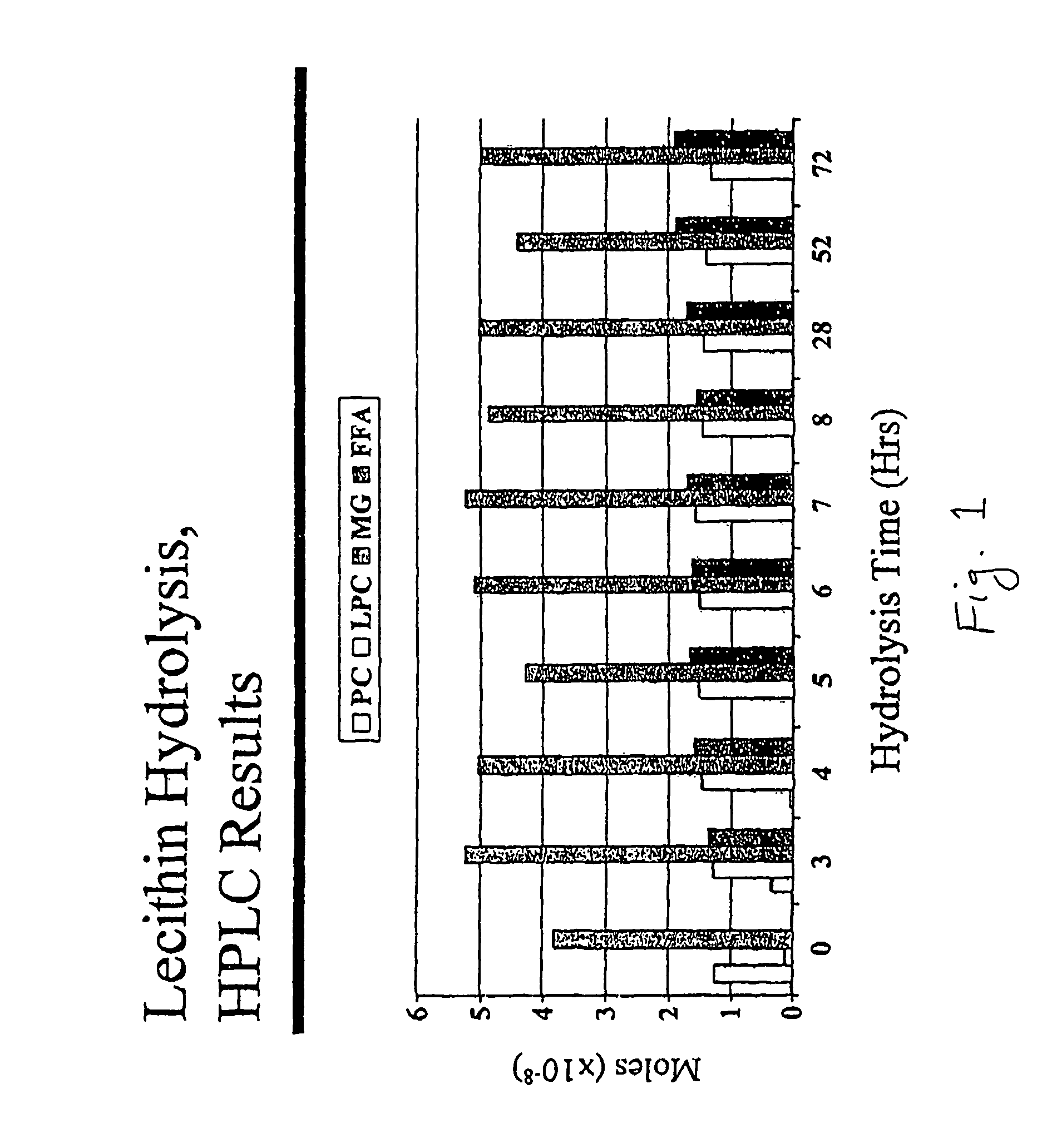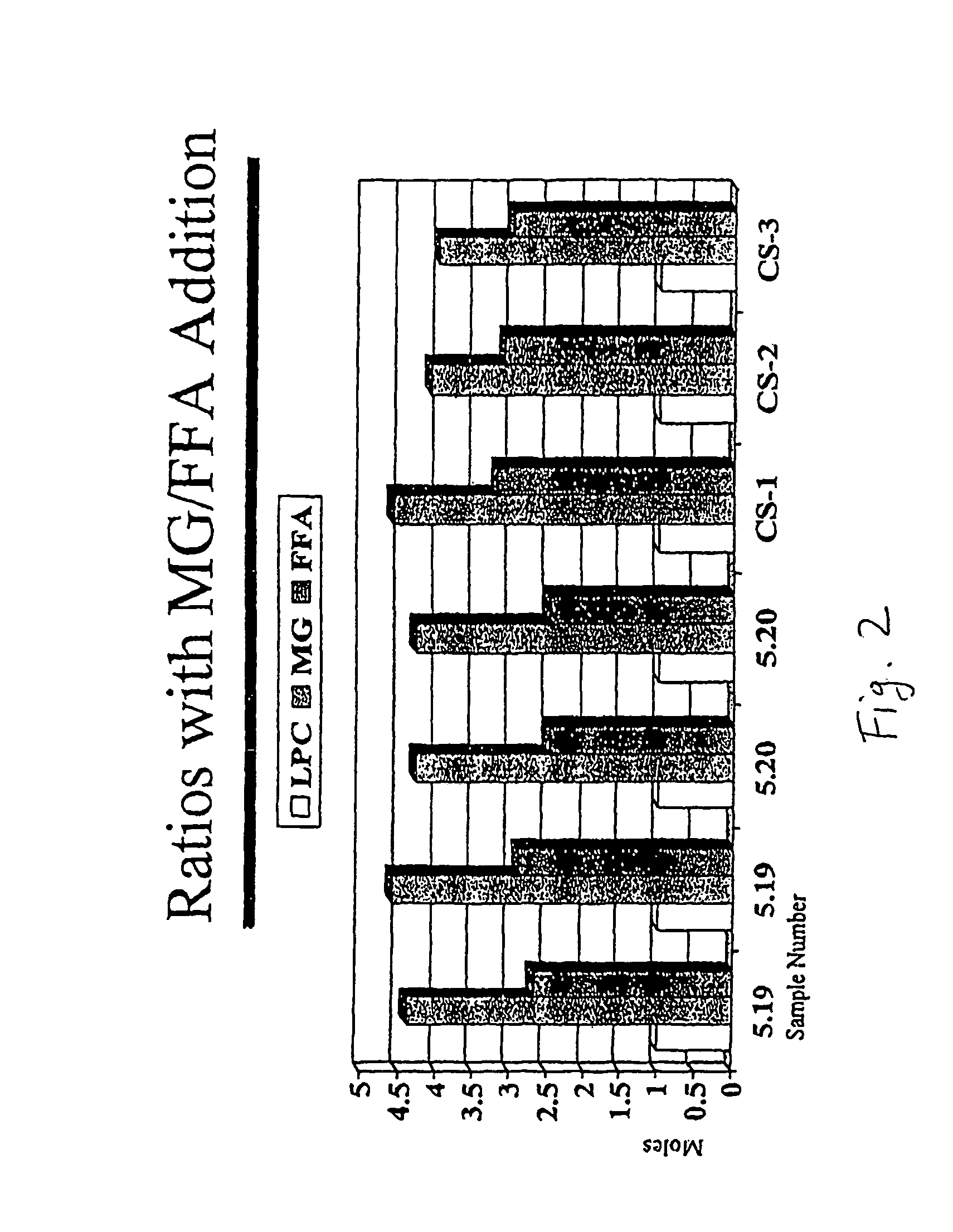Modification of solid 3-sn-phosphoglycerides
a technology of phosphoglyceride and phospholipid, which is applied in the direction of phosphorous compound active ingredients, drug compositions, biocides, etc., can solve the problems of increasing the cost of the final mixed lipid particle product, ethanol and methylisobutylhexane were ineffective in increasing the hydrolysis of phosphatidylcholine, and the prior art methods are severe, so as to reduce the amount of gpc, the effect of reducing the speed of the speed of the phosphoglyceride and phosphoglyceride and phosphoglyceride and phosphoglyceride and phosphoglyceride and phosphoglyceride phosphoglyceride and phosphoglyceride and phosphoglyceride and phospholipids, which is applied in the field of phospholipid hydrolysis rate and the effect of phospholipids
- Summary
- Abstract
- Description
- Claims
- Application Information
AI Technical Summary
Benefits of technology
Problems solved by technology
Method used
Image
Examples
example 1
Preparation of lysophosphatidylcholine and Lipid Matrix Compositions
Hydrolysis of Solid Phosphatidylcholine
[0086]Briefly, using a more economical, solid matrix, ungranulated form of soy PC (Nattermann 8729, Nattermann Aventis Pharma Deutschland GmbH, Cologne, Germany) and an efficient mixing apparatus (Littleford / Day reactor, Model M5, ½ HP motor, 5 L capacity, Littleford Day Inc., Florence, Ky.), the hydrolysis of PC to lysophosphatidylcholine (LPC) using phospholipase A2 and monoglyceride (MG) was complete (>99%) within 5-6 hours. In the following experiments 400 g of Nattermann 8729 were hydrolyzed in a 5 L Littleford / Day reactor. The load phospholipid, monoglyceride, phospholipase A2 enzyme, buffer and water represented approximately 40% of the 5 liter capacity of the reactor.
[0087]In the hydrolysis of phosphatidylcholine (PC) using the enzyme phospholipase A2 (PLA2) (Lecitase, Novo Nordisk, Denmark), approximately 300,000 Lecitase Units (one unit produces 1 μmole of fatty acid ...
example 2
Analysis of Physical Properties of Lipid Matrix Preparations
Birefringent and Rheological Characteristics
[0104]Example 1 shows a modification of the method to hydrolyze phosphatidylcholine (PC) and to produce an organized lipid matrix of PC, monoglyceride (MG) and fatty acids (FA). Using the same Littleford / Day reactors [Model M5, ½HP and 1 HP motors], the 30% water content of the reaction was removed with vacuum and heat within 16-18 hours. The resulting basic neat lipid matrix, when viewed in a polarizing light microscope, exhibited a unique birefringence of unknown structure that was different from the lamellar and hexagonal phases of phosphatidylcholine and phosphatidylethanolamine, respectively (FIG. 3), but may be similar to the birefringent liquid crystalline phases in human intestinal contents during fat digestion (Holt, Fairchild and Weiss, Lipids 21:444-446, 1986).
[0105]Viscosity is the measure of the internal friction of a fluid. As shown in FIGS. 4 and 5, the basic neat l...
example 3
LYM-X-SORB™ Uses
Palatable Taste Characteristics
[0131]The addition of calcium ions and / or water in defined molar ratios relative to the lipid matrix are factors that contribute to a more palatable lipid matrix formulation for use as a nutritional supplement, e.g. LYM-X-SORB™ (BioMolecular Products, Inc., Byfield, Mass.), for use in cystic fibrosis (CF). It is known that polymorphic changes in PC and MG depend on the thermal history, the rate of cooling, the temperature of equilibrium and other factors (Small, The Physical Chemistry of Lipids from Alkanes to Phospholipids, Handbook of Lipid Research 4, Plenum Press, New York, N.Y., 1986, pp. 386-392, 475-517). Thus, the physical chemistry of the product needs to be better defined in order to control the final palatability of the organized lipid matrix. Using the analytical methods described above (x-ray diffraction, differential scanning calorimetry and phosphorus NMR data analysis), the phase behavior and organization (intramolecular...
PUM
| Property | Measurement | Unit |
|---|---|---|
| Fraction | aaaaa | aaaaa |
| Time | aaaaa | aaaaa |
| Percent by mass | aaaaa | aaaaa |
Abstract
Description
Claims
Application Information
 Login to View More
Login to View More - R&D
- Intellectual Property
- Life Sciences
- Materials
- Tech Scout
- Unparalleled Data Quality
- Higher Quality Content
- 60% Fewer Hallucinations
Browse by: Latest US Patents, China's latest patents, Technical Efficacy Thesaurus, Application Domain, Technology Topic, Popular Technical Reports.
© 2025 PatSnap. All rights reserved.Legal|Privacy policy|Modern Slavery Act Transparency Statement|Sitemap|About US| Contact US: help@patsnap.com



